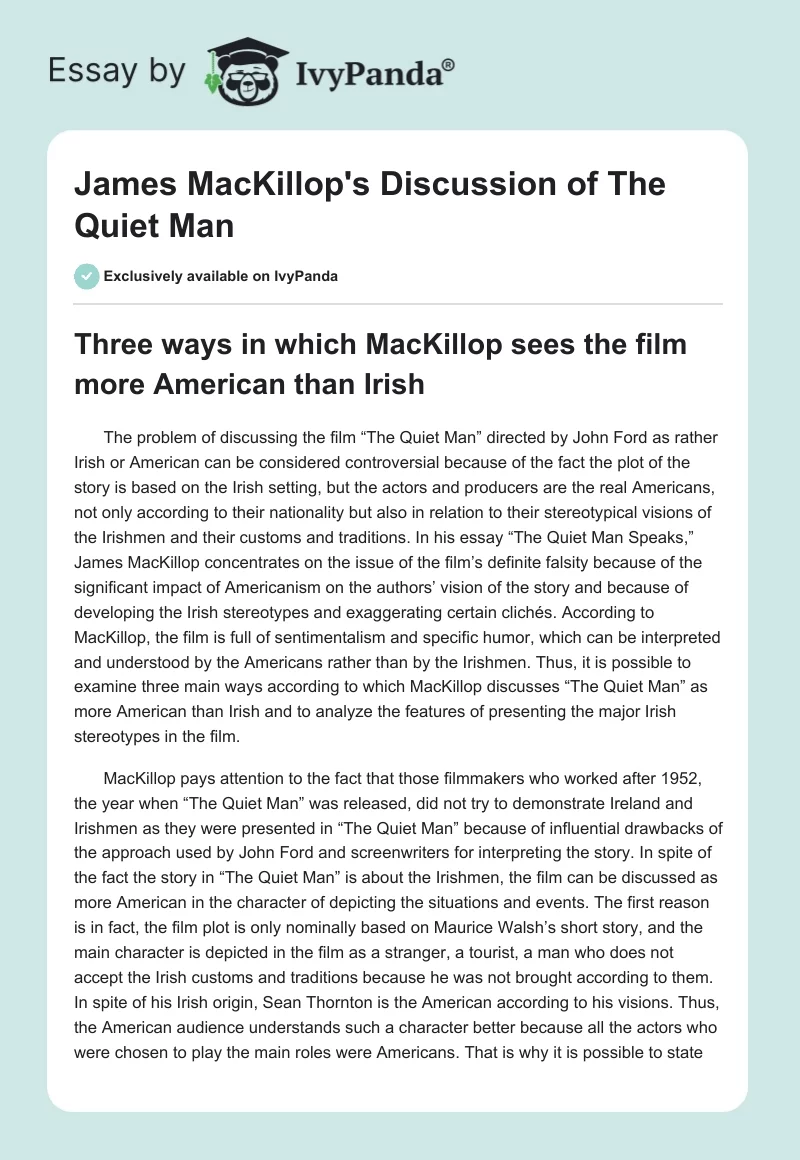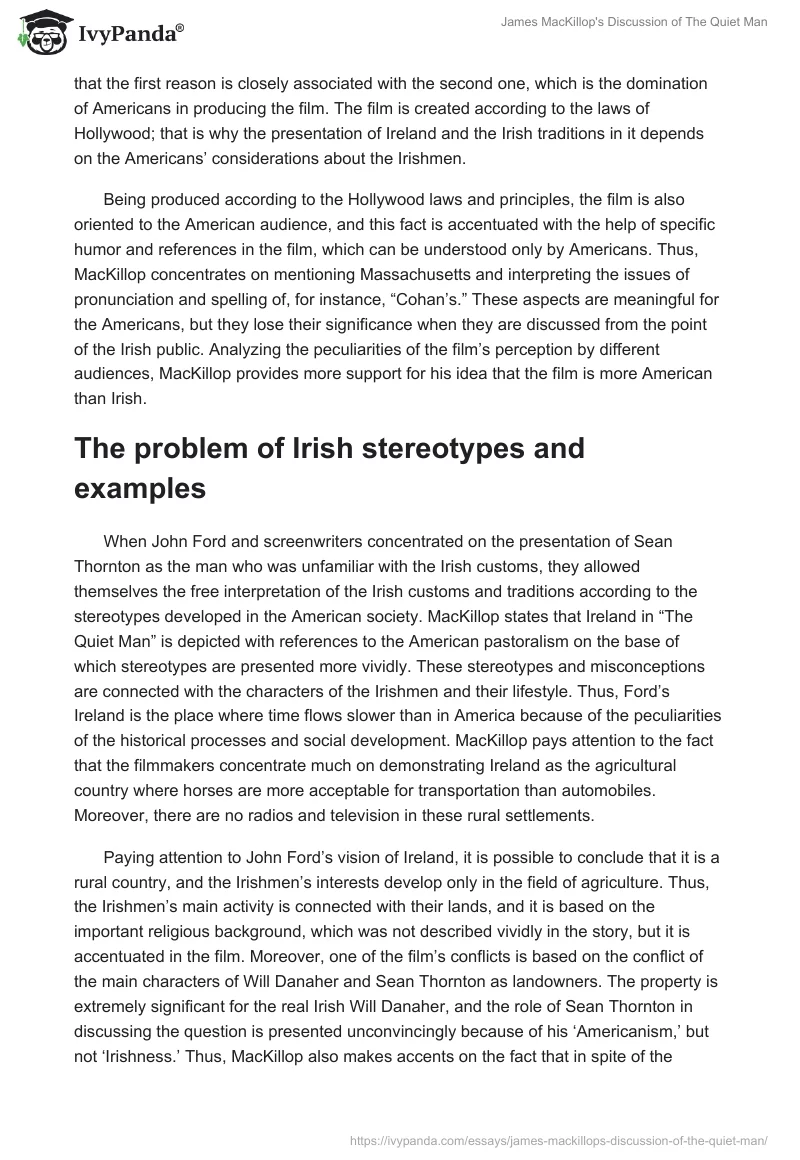Three ways in which MacKillop sees the film more American than Irish
The problem of discussing the film “The Quiet Man” directed by John Ford as rather Irish or American can be considered controversial because of the fact the plot of the story is based on the Irish setting, but the actors and producers are the real Americans, not only according to their nationality but also in relation to their stereotypical visions of the Irishmen and their customs and traditions. In his essay “The Quiet Man Speaks,” James MacKillop concentrates on the issue of the film’s definite falsity because of the significant impact of Americanism on the authors’ vision of the story and because of developing the Irish stereotypes and exaggerating certain clichés. According to MacKillop, the film is full of sentimentalism and specific humor, which can be interpreted and understood by the Americans rather than by the Irishmen. Thus, it is possible to examine three main ways according to which MacKillop discusses “The Quiet Man” as more American than Irish and to analyze the features of presenting the major Irish stereotypes in the film.
MacKillop pays attention to the fact that those filmmakers who worked after 1952, the year when “The Quiet Man” was released, did not try to demonstrate Ireland and Irishmen as they were presented in “The Quiet Man” because of influential drawbacks of the approach used by John Ford and screenwriters for interpreting the story. In spite of the fact the story in “The Quiet Man” is about the Irishmen, the film can be discussed as more American in the character of depicting the situations and events. The first reason is in fact, the film plot is only nominally based on Maurice Walsh’s short story, and the main character is depicted in the film as a stranger, a tourist, a man who does not accept the Irish customs and traditions because he was not brought according to them. In spite of his Irish origin, Sean Thornton is the American according to his visions. Thus, the American audience understands such a character better because all the actors who were chosen to play the main roles were Americans. That is why it is possible to state that the first reason is closely associated with the second one, which is the domination of Americans in producing the film. The film is created according to the laws of Hollywood; that is why the presentation of Ireland and the Irish traditions in it depends on the Americans’ considerations about the Irishmen.
Being produced according to the Hollywood laws and principles, the film is also oriented to the American audience, and this fact is accentuated with the help of specific humor and references in the film, which can be understood only by Americans. Thus, MacKillop concentrates on mentioning Massachusetts and interpreting the issues of pronunciation and spelling of, for instance, “Cohan’s.” These aspects are meaningful for the Americans, but they lose their significance when they are discussed from the point of the Irish public. Analyzing the peculiarities of the film’s perception by different audiences, MacKillop provides more support for his idea that the film is more American than Irish.
The problem of Irish stereotypes and examples
When John Ford and screenwriters concentrated on the presentation of Sean Thornton as the man who was unfamiliar with the Irish customs, they allowed themselves the free interpretation of the Irish customs and traditions according to the stereotypes developed in the American society. MacKillop states that Ireland in “The Quiet Man” is depicted with references to the American pastoralism on the base of which stereotypes are presented more vividly. These stereotypes and misconceptions are connected with the characters of the Irishmen and their lifestyle. Thus, Ford’s Ireland is the place where time flows slower than in America because of the peculiarities of the historical processes and social development. MacKillop pays attention to the fact that the filmmakers concentrate much on demonstrating Ireland as the agricultural country where horses are more acceptable for transportation than automobiles. Moreover, there are no radios and television in these rural settlements.
Paying attention to John Ford’s vision of Ireland, it is possible to conclude that it is a rural country, and the Irishmen’s interests develop only in the field of agriculture. Thus, the Irishmen’s main activity is connected with their lands, and it is based on the important religious background, which was not described vividly in the story, but it is accentuated in the film. Moreover, one of the film’s conflicts is based on the conflict of the main characters of Will Danaher and Sean Thornton as landowners. The property is extremely significant for the real Irish Will Danaher, and the role of Sean Thornton in discussing the question is presented unconvincingly because of his ‘Americanism,’ but not ‘Irishness.’ Thus, MacKillop also makes accents on the fact that in spite of the pastoralist pictures and emphases on the role of property and lands for the Irishmen, the process of Sean Thornton’s gardening looks rather implausibly in comparison with the descriptions provided in the published short story. To consider the Irishmen only as landowners occupied with their agricultural issues is the developed stereotype.
The next important conflict depicted in the film is the question of Mary Kate’s dowry. The importance of the dowry for the Irish woman is presented with the help of accentuating the opposing idea, which is expressed by Sean Thornton. MacKillop draws the audience’s attention to the fact that Sean Thornton states in the film, “if this were the States, I’d just blow my horn in front of the girl’s house, and she’d come runnin’.” From this point, it is possible to speak about the contrast of the perception of the problem of dowry as the question of the Irish traditions supported by Mary Kate Danaher and the vision of the problem as the realization of the stereotypical ‘Irishness’ in discussing the issues of marriage. Mary Kate Danaher tries to explain the role of receiving the dowry for a young woman in Ireland to Sean Thornton, but his vision of relations between men and women, courtship, and marriage is based on the American traditions, but not on the Irish ones.
That is why the requirement of the payment of Mary Kate’s dowry is perceived as an example of the Irish archaic marriage traditions which contribute to the development of stereotypes. The dowry is presented as the guarantee of the woman’s identity and independence. Thus, when Sean rejects asking the dowry, Mary Kate feels being ashamed by the fact because it is the question of her pride and the further position in the family. Mary Kate decides that Sean’s actions and behavior cannot be discussed as appropriate for her husband and refuses to communicate with him. MacKillop focuses on the fact that the problem is not in Sean Thornton’s quietness in relation to asking the dowry as it was depicted in Maurice Walsh’s short story but in the main character’s visions of the issue from the point of his relaying on the American customs and traditions.
The climactic episode of the film is the situation of May Kate’s receiving the dowry in the form of money and Sean Thornton’s throwing the money in the fire. According to MacKillop, the tradition of accentuating the woman’s independence in marriage with the help of providing the necessary dowry is presented from two different perspectives in the story and in the film. The authors of the film focus on the problem with references to Sean’s Americanism and his position as a stranger in Ireland, where all the customs are unfamiliar for him. The Irishmen are depicted as the representatives of the archaic world in which customs and traditions are more important than the people’s real feelings and emotions. One of the most controversial scenes in the film is the representation of the situation when Sean forces Mary Kate to go across the fields. This scene can be considered as the exaggeration of the Irish temper, which is discussed in connection with the other stereotypes developed in relation to the Irishmen’s character and typical behavior. However, MacKillop states that a lot of scenes in the film are full of solecisms, which are explained from the point of creating the film by the Americans. That is why it is unreasonable to make conclusions about the characteristics of the Irishmen basing on stereotypes and misconceptions.
Sean Thornton’s quietness in the film is the result of his escaping the effects of the previous life in the USA, where he accidentally killed his opponent while boxing. Thus, Ireland has represented as not the familiar country for the main character, but as the land with unusual and rather strange customs and traditions, the depiction of which in the film is associated with a lot of stereotypes. MacKillop draws the audience’s attention to the fact that rural Ireland is depicted in opposition to industrial America and its traditions. Furthermore, the Irishmen are traditionally perceived by Americans as having red hair and expressing their tempers while conflicting and fighting. In this case, the quietness of Sean Thornton in relation to conflicts is accentuated.
In his essay “The Quiet Man Speaks,” James MacKillop opens a discussion of such controversial points as the problem of perceiving the film “The Quiet Man” as rather American than Irish in relation to its peculiar features and the issue of presenting the Irishmen, their country, and their lifestyle as dependent on numerous archaic visions and ideas. Thus, a lot of Irish stereotypes that exist in American society are vividly depicted in the film. The majority of the Irishmen presented in “The Quiet Man” has red hair and like to drink and fight, spend much time cultivating their lands and enlarging their


